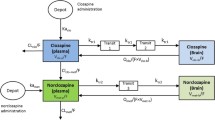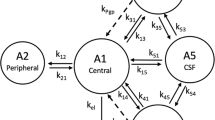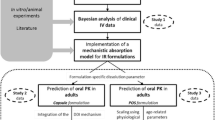Abstract
Pharmacological inhibition of GABA uptake transporters provides a mechanism for increasing GABAergic transmission, which may be useful in the treatment of various neurological disorders. The purpose of our investigations was to develop an integrated pharmacokinetic–pharmacodynamic (PK/PD) model for the characterization of the pharmacological effect of tiagabine, R-N-(4,4-di-(3-methylthien-2-yl)but-3-enyl)nipecotic acid, in individual rats in vivo. The tiagabine-induced increase in the amplitude of the EEG 11.5–30 Hz frequency band (β), was used as pharmacodynamic endpoint. Chronically instrumented male Wistar rats were randomly allocated to four groups which received an infusion of 3, 10, or 30 mg kg −1 \((\bar x \pm SE,{\text{ }}n = 23)\) \(96 \pm 9\) ml min -1 kg−1, 1.5ŷ0.1 L kg−1 and 20ŷ0.2 min.A time delay was observed between the occurrence of maximum plasma drug concentrations and maximal response. A physiological PK/PD model has been used to account for this time delay, in which a biophase was postulated to account for tiagabine available to the GABA uptake carriers in the synaptic cleft and the increase in EEG effect was considered an indirect response due to inhibition of GABA uptake carriers. The population values for the pharmacodynamic parameters characterizing the delay in pharmacological response relative to plasma concentrations were keo=0.030 min −1 and kout=81 min−1, respectively. Because of the large difference in these values the PK/PD model was simplified to the effect compartment model. Population estimates \((\bar x \pm SE)\) were E0=155 ŷ 6 μV, Emax=100 ŷ 5 μV, EC50=287 ŷ 7 ng ml−1, Hill factor=1.8 ŷ 0.2 and keo=0.030 ŷ 0.002 min −1. The results of this analysis show that for tiagabine the combined “effect compartment-indirect response” model can be simplified to the classical “effect compartment” model.
Similar content being viewed by others
REFERENCES
P. Krogsgaard-Larsen. Inhibitors of the GABA uptake systems. Mol. Cel. Biochem. 31:105-121(1980).
P. Krogsgaard-Larsen, O. M. Larsson, and A. Schousboe. GABA uptake inhibitors: relevance to antiepileptic drug research. Epileps. Res. 1:77-93 (1987).
F. E. Ali, W. E. Bondinell, P. A. Dandridge, J. S. Frazee, E. Garvey, G. R. Girard, C. Kaiser, T. W. Ku, J. J. Lafferty, G. I. Moonsammy, H.-J. Oh, J. A. Rush, P. E. Setler, O. D. Stringer, J. W. Venslavsky, B. W. Volpe, L. M. Younger, and C. L. Zirke. Orally active and potent inhibitors of gamma-aminobutyric acid uptake. J. Med. Chem. 28:653-660 (1985).
C. Braestrup, E. B. Nielsen, U. Sonnewald, L. J. S. Knutsen, K. E. Andersen, J. A. Jansen, K. Frederiksen, P. H. Andersen, A. Mortensen, and P. Suzdak, (R)-N-[4,4-Bis(3-Methyl-2-thienyl)but-3-en-1-yl]Nipecotic acid binds with high affinity to the brain γ-aminobutyric acid uptake carrier. J. Neurochem. 54:639-647 (1990).
P. Suzdak and J. A. Jansen. A review of the preclinical pharmacology of tiagabine: a potent and selective anticonvulsant GABA uptake inhibitor. Epilepsia 36:612-626 (1995).
W. J. Jusko and H. C. Ko. Physiologic indirect response models characterize diverse types of pharmacodynamic effects. Clin. Pharmacol. Ther. 56:406-419 (1994).
N. L. Dayneka, V. Garg, and W. J. Jusko. Comparison of four basic models of indirect pharmacodynamic responses. J. Pharmacokin. Biopharm. 21:457-478 (1993).
L. B. Sheiner, D. R. Stanski, S. Vozeh, R. D. Miller, and J. Ham. Simultaneous modelling of pharmacokinetics and pharmacodynamics: Application to d-tubocurarine. Clin. Pharmacol. Ther. 25:358-371 (1979).
R. Nagashima, R. A. O'Reilly, and G. Levy. Kinetics of pharmacologic effects in man: the anticoagulant action of warfarin. Clin. Pharmacol. Ther. 10:22-35 (1969).
Z.-X. Xu, Y.-N. Sun, D. C. DuBois R. R. Almon, and W. J. Jusko. Third-generation model for corticosteroid pharmacodynamics: roles of glucocorticoid receptor mRNA and tyrosine aminotransferase mRNA in rat liver. J. Pharmacokin. Biopharm. 23: 163-181 (1995).
G. L. Levy. Mechanism-based pharmacodynamic modelling. Clin. Pharmacol. Ther. 56:356-357 (1994).
D. Verotta and L. B. Sheiner. A general conceptual model for non-steady state pharmacokinetic/pharmacodynamic data. J. Pharmacokin. Biopharm. 23:1-4 (1995).
W. J. Jusko, H. C. Ko, and W. F. Ebling. Convergence of direct and indirect pharmacodynamic response models. J. Pharmacokin. Biopharm. 23:5-8 (1995).
D. Verotta and L. B. Sheiner. Rejoinder. J. Pharmacokin. Biopharm. 23:9-10 (1995).
J. W. Mandema and M. Danhof. Pharmacokinetic-pharmacodynamic modelling of the central nervous system effects of heptabarbital using aperiodic EEG analysis. J. Pharmacokin. Biopharm. 18:459-481 (1990).
L. E. Gustavson and S.-Y. Chu. High performance liquid chromatographic procedure for the determination of tiagabine concentrations in human plasma using electrochemical detection. J. Chrom. 574: 313-318 (1992).
R. C. Schoemaker and A. F. Cohen. Estimating impossible curves using NONMEM. Br. J. Clin. Pharmacol. 42:283-290 (1996).
S. L. Beal and L. B. Sheiner (eds.). NONMEM users guide, NONMEM project group, University of California, San Francisco, CA (1992).
H. Akaike. A new look at the statistical model identification. IEEE Transactions on Automat. Control 19:716-723 (1974).
M. Gibaldi and D. Perrier. Non-compartmental analysis based on statistical moment theory. In Pharmacokinetics (2nd ed.), Marcel Dekker, New Yorkm 1982, pp. 409-424.
A. Fink-Jensen, P. D. Suzdak, M. D. B. Swedberg, M. E. Judge, L. Hansen, and P. G. Nielsen. The γ-aminobutyric acid (GABA) uptake inhibitor, tiagabine, increases extracellular brain levels of GABA in awake rats. Eur. J. Pharmacol. 220:197-201 (1992).
M. Lancel, J. Faulhaber, and R. A. Deisz. Effect of the GABA uptake inhibitor tiagabine on sleep and EEG power spectra in the rat. Br. J. Pharmacol. 123:1471-1477 (1998).
A. M. L. Coenen, E. H. M. Blezer, and V. Luijtelaar. Effects of the GABA uptake inhibitor tiagabine on electroencephalogram, spike-wave discharges and behaviour of rats. Epilepsy Res. 21:89-94 (1995).
L. B. Sheiner and D. Verotta. Further notes on physiological indirect response models. Clin. Pharmacol. Ther. 58:238-240 (1995).
E. A. Van Schaick, H. J. M. M. De Graaf, A. P. IJzerman, and M. Danhof. Physiological indirect effect modelling of the anti-lipolytic effects of adenosine A1 receptor agonists. J. Pharmacokin. Biopharm. 25:713-730 (1997).
E. Snoeck, V. Pitrovskij, P. Jacqmin, A. Van Peer, M. Danhof, K. Ver Donck, R. Woestenborghs, H. Van Belle, L. Van Bortel, R. Van Gool, A. Dupont, and J. Heykants. Population analysis of the nonlinear red blood cell partitioning and the concentration-effect relationship of draflazine following various infusion rates. Br. J. Clin. Pharmacol. 43:603-612 (1997).
E. Snoeck, K. Ver Donck, P. Jacqmin, H. Van Belle, A. G. Dupont, A. Van Peer, and M. Danhof. Physiological red blood cell kinetic model to explain the apparent discrepancy between adenosine breakdown inhibition and nucleoside transport occupancy of draflazine. J. Pharmacol. Exp. Ther. 286:142-149 (1998).
J. C. Rekling, H. Jahnsen, and A. M. Laursen. The effect of two lipophilic γ-aminobutyric acid uptake blockers in CA1 of the rat hippocampal slice. Br. J. Pharmacol. 99:103-106 (1990).
C. H. Davies, S. N. Davies, and G. L. Collingridge. Paired-pulse depression of monosynaptic GABA-mediated inhibitory post-synaptic responses in rat hippocampus. J. Physiol. 424:513-531 (1990).
S. M. Thompson and B. H. Gähwiler. Effects of the GABA uptake inhibitor tiagabine on inhibitory synaptic potentials in rat hippocampal slice cultures. J. Neurophysiol. 67:1698-1701 (1992).
A. Cleton, R. A. Voskuyl, and M. Danhof. Adaptive changes in the pharmacodynamics of midazolam in different models of epilepsy: kindling, cortical stimulation, genetic absence epilepsy. Br. J. Pharmacol. 125:615-620 (1998).
J. W. Mandema, E. Tukker, and M. Danhof. Pharmacokinetic-pharmacodynamic modelling of the EEG effects of midazolam in individual rats: influence of rate and route of administration. Br. J. Pharmacol. 102:663-668 (1991).
A. Wessén, K. Parivar, M. Widman, A. Nilsson, and P. Hartvig. Concentration-effect relationships of eltanolone given as a bolus dose or constant rate intravenous infusion to healthy male volunteers. Anesthesiology 84:1317-1326 (1996).
A. Patat, F. le Coz, C. Dubruc, J.-M. Gandon, G. Durrieu, I. Cimarotsi, S. Jezequil, O. Curet, I. Zieleniuk, H. Allain, and P. Rosenzwieg. Pharmacodynamics and pharmacokinetics of two dosage regimens of befloxatone, a new reversible and selective monoamine oxidase inhibitor, at steady state in healthy volunteers. J. Clin. Pharmacol. 36:216-229 (1996).
E. H. Cox, T. Kerbusch, P. H. van der Graaf, and M. Danhof. Pharmacokinetic-pharmacodynamic modelling of the EEG effect of synthetic opioids in the rat: correlation with the interaction at the μ-opioid receptor. J. Pharmacol. Exp. Ther. 284:1095-1103 (1998).
T. Rydberg, A. Jönsson, M. O. Karlsson, and A. Melander. Concentration-effect relations of glibenclamide and its active metabolites in human: modelling of pharmacokinetics and pharmacodynamics. Br. J. Clin. Pharmacol. 43:373-381 (1997).
Author information
Authors and Affiliations
Corresponding author
Rights and permissions
About this article
Cite this article
Cleton, A., de Greef, H.J.M.M., Edelbroek, P.M. et al. Application of a Combined “Effect Compartment/Indirect Response Model” to the Central Nervous System Effects of Tiagabine in the Rat. J Pharmacokinet Pharmacodyn 27, 301–323 (1999). https://doi.org/10.1023/A:1020999114109
Published:
Issue Date:
DOI: https://doi.org/10.1023/A:1020999114109




